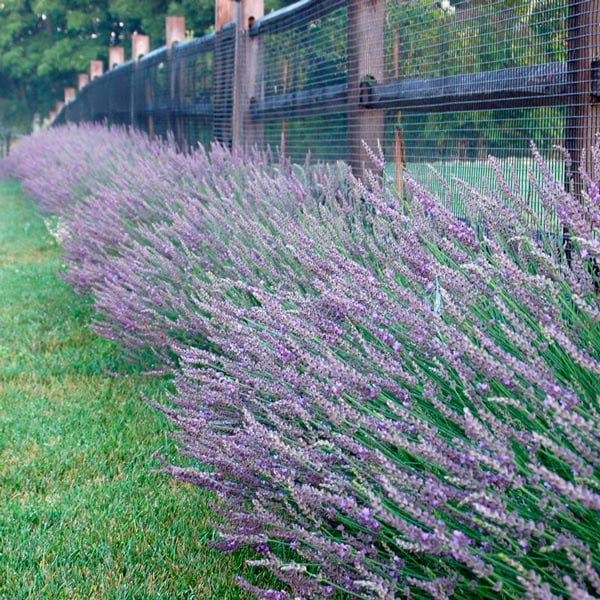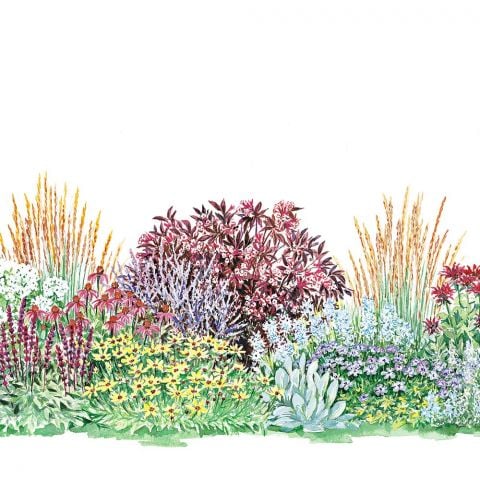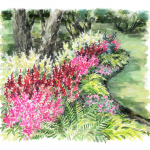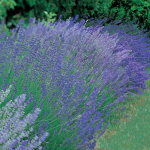How to Design a Deer-Resistant Garden

As many gardeners have had the misfortune of learning, a hungry herd of deer can quickly decimate a garden. Fortunately, your garden dreams can still be reality even if you live in a neighborhood frequented by deer. From Deer-Resistant Plants & Bulbs to physical deer-deterrents and barriers, you have options for designing a deer-resistant garden.
Choose Deer-Resistant Plants
First, the caveat: there are no plants that are absolutely deer-proof. If the herd is large enough, and food is scarce enough, deer have been known to eat almost anything. We’ve had customers lose Rugosa Roses to deer—hard to believe for anyone who’s ever tried to prune a Rugosa without drawing blood! If the deer herd is large, the youngsters can do some damage by sampling plants and then spitting them out—we've heard of deer tearing up and then leaving Narcissus (Daffodils) and Digitalis (Foxgloves), both quite poisonous. That's how the young learn what's good—or not good—to eat.
That said, there are some plants that are much less palatable to deer. Deer-Resistant Plants & Bulbs tend to share certain characteristics: fuzzy or wooly leaves, pungent-scented foliage (Catmints, Mints, Lavenders, Agastache, Salvias, etc), barbs or thorns, and/or foul taste.
Deer tend to have regional tastes, so some plants that are "rarely eaten" in one region are considered "sometimes eaten" in others. When in doubt, it's always a good idea to consult your local cooperative extension office or other gardeners in your neighborhood for region-specific advice. Deer also seem to have an uncanny ability to find (and eat) fertilized plants, so go easy on the nitrogen if you feed your plants.
If you have a deer problem in your neighborhood, consider drawing heavily from this list of deer-resistant perennials and bulbs:
Deer Resistant Plants We Offer:
Shop All Deer Resistant Plants
 Deer-Resistant Garden for Sun
Deer-Resistant Garden for Sun
Deer Resistant Perennials for Sun
- Agastache
- Ajuga reptans
- Amsonia tabernaemontana(Bluestar)
- Anemone sp.
- Aquilegia (Columbine)
- Artemesia
- Asarum europaeum
- Asclepias tuberosa (Butterfly Weed)
- Baptisia australis
- Boltonia asteroides
- Buddleia davidii (Butterfly Bush)
- Calamintha
- Calluna (Heather)
- Campanula carpatica (Bellflower)
- Centaurea sp.
- Ceratostigma plumbaginoides
- Chrysanthemum x superbum (sometimes nipped)
- Cimicifuga racemosa
- Coreopsis sp.
- Delphinium
- Echinacea purpurea (Purple Coneflower)
- Echinops
- Erica (Heath)
- Eupatorium (Joe-Pye Weed)
- Euphorbia (Spurge)
- Geranium (especially G. macrorrhizum)
- Grasses, Ornamental (Calamagrostis, Miscanthus, Pennisetum, Festuca, Hakonechloa)
- Gypsophila paniculata (Baby's Breath)
- Helenium
- Iberis sempervirens
- Iris sibirica
- Lavandula (Lavender)
- Liatris spicata(Gayfeather)
- Linum perenne
- Lupinus
- Monarda (Bee Balm)
- Nepeta (Catmint)
- Oenothera (Evening Primrose)
- Paeonia (Peony)
- Perovskia (Russian Sage)
- Platycodon grandiflorus (Balloon Flower)
- Potentilla sp.
- Rosmarinus officinalis (Rosemary)
- Salvia sp.
- Solidago (Goldenrod)
- Stachys byzantinus (Lamb's Ears)
- Thymus (Thyme)
- Verbascum sp (Mullein)
- Veronica latifolia
- Wisteria
- Yucca
Deer-Resistant Plants for Shade
- Asarum (Ginger)
- Bergenia
- Convallaria (Lily of the Valley)
- Dicentra (Bleeding Heart)
- Digitalis sp (Foxglove)
- Geranium (especially G. macrorrhizum) - hardy perennial geranium
- Helleborus (Hellebore) - perennial flowering plant for partial shade
- Kirengeshoma palmata (Waxbells) - shade loving perennial (shrublike: 3-4’)
- Lamium sp - ground cover for sun or part-shade
- Primula sp (Primrose) - part shade perennials
- Pulmonaria sp (Lungwort) - perennial for shade
Ferns
- Adiantum pedatum - Maidenhair Fern
- Athyrium 'Ghost'
- Athyrium niponicum 'Pictum' - Japanese Painted Fern
- Dennstaedtia punctilobula - Hay-scented Fern
- Matteuccia struthiopteris - Ostrich Fern
- Onoclea sensibilis
- Osmunda cinnamomea - Cinnamon Fern
- Osmunda claytoniana
- Osmunda regalis
- Polystichum acrostichoides - Christmas Fern
Flowering Bulbs Rarely Damaged by Deer
- Allium
- Chionodoxa
- Colchicum
- Fritillaria imperialis (Crown Imperial)
- Galanthus (Snowdrop)
- Hyacinthus
- Narcissus (Daffodil, Jonquil)
- Scilla (Squill)
Although it's the curse of gardeners that we crave what we can't grow (folks in Florida long for Lilacs, New Englanders for Agapanthus), it is possible to create a lovely garden using Deer-Resistant Plants & Bulbs.
Deer Deterrents and Barriers
Even if your garden abounds with deer-resistant plants, hungry deer may still come grazing. If you’re still having problems with deer in your deer-resistant garden or you prefer to include plants that deer love, you may want to try physical deterrents and barriers to keep your plants safe. Some ways to keep your plants safe from deer include:
- Windchimes and Sprinklers – sudden noises or sprays of water can startle deer, deterring them from dallying too long in your garden.
- Deer Repellant – consider using sprays designed specifically to repel deer or apply natural fertilizers that deer dislike, such as fish emulsion and blood meal.
- Place Plants out of Reach - if you can’t live without certain plants that are candy to deer, plant them in containers that you can hang up high or place on fences or decks that deer can’t easily reach.
- Create Natural Barriers - use thorny bushes or strong-smelling herbs as border plants to protect your garden from nosy nibblers.
- Build a Fence (or Two) - many serious gardeners resist building fences, but there is no doubt that they work. If you decide to build a fence to keep deer out, you’ll need a six- to seven-foot high fence that deer can’t easily jump (make sure it is secure at ground level to keep deer from wiggling under as well). Alternately, you could place two shorter fences about four feet apart since deer are typically wary of situations where they might become trapped.




